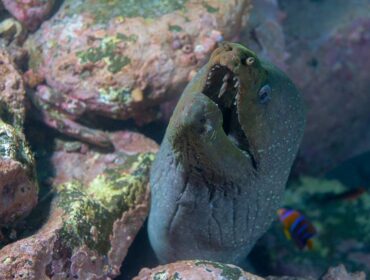Among the many types of creatures found across the planet, eels and sea snakes are often mistaken for each other in the wild. These two animals often inhabit similar environments, look somewhat alike, and may display similar characteristics. For this reason, people often confuse the sea snake vs eel. However, there are some vast differences between these two striking animals.
Among the many types of creatures found across the planet, marine eels and sea snakes are often mistaken for each other in the wild. After seeing the former, it’s common for divers to ask: are eels snakes? The truth is, both species are in similar environments, but they coexist with different characteristics and behaviors that might not be readily apparent. It might not affect your time in the water, but the differences between eels and sea snakes are important to know.
Sea Snake vs Eel

We’ll differentiate eels from sea snakes by pointing out their major distinctions—particularly in terms of their species, physical characteristics, habitat, as well as their predatory nature.
Species
Are eels related to sea snakes? Judging by their anatomy, definitely not.
Eels are actually fish (albeit typically longer) and are flatter than snakes. As marine animals and unlike reptiles, eels breathe underwater with their gills and fins, and therefore cannot survive outside of water.
Meanwhile, sea snakes are indeed snakes—reptiles, just like the non-marine varieties—that only live in marine environments. And since snakes have lungs, they need to resurface at some point regardless of how well they hold air.
Physical Appearance
In the water, sea snakes often look more like a swimming rope, while eels appear more like a ribbon, in shape, texture, and movement. The snake’s body is cylindrical, much like any other snake, but the head may have a flatter appearance, depending on the species. In addition, the tail end of the snake is often paddle-shaped, which helps the snake propel itself through the water.

On the other hand, eels are a specific type of elongated fish and live in both marine and freshwater environments. The appearance of each of these fish species differs, but usually, they are much flatter, in the vertical sense, than a snake. In addition, these fish’s heads tend to be longer and sharper. These fish also have fins, which sea snakes never have. The fins are often located along the top or bottom of the fishes’ body or protruding from just behind the head.
Although both of these creatures have scales, they are unique in their own way. For one, each have different patterns and colors. Secondly, the scales of a snake are much easier to see as the pattern is clearly visible to the naked eye. The eel’s scales, however, are much smaller, giving the animal a smoother appearance.
Habitat
Eels live in both freshwater and marine environments, while sea snakes mainly inhabit marine areas, such as coral reefs. Simply determining where you’re swimming can help differentiate whether or not you’re seeing a sea snake. At the same time, sea snakes mainly living in marine areas help make encounters less frequent—a crucial benefit considering the next distinction below.

Predatory Nature
The most vital difference between eels and sea snakes for humans is that sea snakes are more dangerous. They are almost always poisonous and their venom ranges from mild to deadly, with most known species being on the more dangerous end of the spectrum. Some of them even prey on eels, so if one is spotted trying to swallow another, the differences should be clear.
Eels, on the other hand, are not venomous, but can deliver a nasty bite if you offer your hand — further reinforcing the “don’t touch” creed divers should all know well!
Look but Don’t Touch
No matter where one happens to be when spotting either of these animals, the main difference is that one is a snake and the other a fish; one is venomous and the other is not. While they might appear to be alike, eels and sea snakes aren’t at all the same. The adage “look but don’t touch” will come in handy when one of the creatures comes across your path, so stay alert.




